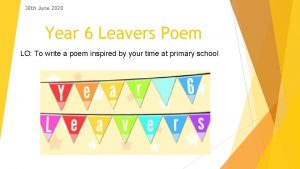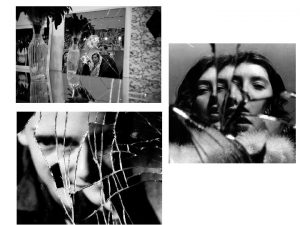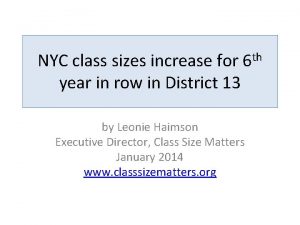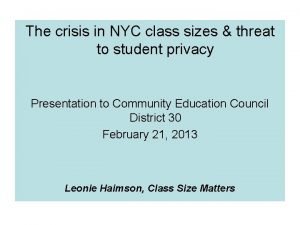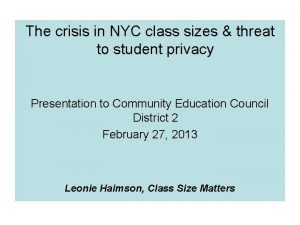NYC class sizes increase for 6 th year























- Slides: 23

NYC class sizes increase for 6 th year in row & why by Leonie Haimson Executive Director, Class Size Matters 11/18/13 www. classsizematters. org

Class sizes in grades K-3 are now the largest since 1998 General ed, CTT and gifted: data from IBO 1998 -2005; DOE 2006 -2013 24, 90 24, 86 24, 46 23, 89 23, 25 22, 38 22, 90 22, 10 21, 68 21, 55 22, 10 21, 28 21, 12 21, 00 20, 90 21, 40 1998/99 1999/00 2000/01 2001/02 2002/03 2003/04 2004/05 2005/06 2006/07 2007/08 2008/09 2009/10 2010/11 2011/12 2012/13 2013/14

Class sizes in grades 4 th-8 th largest since 2002 28, 1 Gened, CTT and gifted: data from IBO 1998 -2005; DOE 2006 -2013 27, 5 27, 2 27, 4 27, 0 26, 7 26, 8 26, 6 26, 7 26, 4 26, 3 25, 9 25, 8 25, 6 25, 1 1998/99 1999/00 2000/01 2001/02 2002/03 2003/04 2004/05 2005/06 25, 3 2006/07 2007/08 2008/09 2009/10 2010 -11 2011/12 2012/13 2013/14

Contracts for Excellence • In 2003, NYS Court of Appeals held that NYC class sizes too large to provide students with constitutional right to a sound basic education. • April 2007, NY State settled the Campaign for Fiscal lawsuit by passing the Contracts for Excellence (C 4 E) law. Legislature agreed to send billions in additional aid to NYC & other high needs school districts to be spent in six approved areas, including class size reduction. • In addition, NYC had to submit a plan to reduce class size in all grades. • In fall of 2007, NYSED approved DOE’s plan to reduce class sizes to an average of no more than 20 students per class in K-3; 23 in grades 4 -8 and 25 in core HS classes over five yeas. • In return, NYS has sent more than $3 billion in C 4 E funds cumulatively to NYC since 2007, though funding has never reached its promised full level.

C 4 E regulations • iv) beginning in the 2008 -2009 school year and continuing through the 2011 -2012 school year, the city school district of the city of New York shall: • (A) establish annual class size reduction goals for each grade level targeted that will reduce class size toward the prekindergarten through grade 12 targets as prescribed by the commissioner after his/her consideration of the recommendation of an expert panel appointed by the commissioner to conduct a review of existing class size research; • (B) make measurable progress in each such school years toward achieving such targets; and • (C) not exceed such targets by the end of the 2011 -2012 school year; http: //www. p 12. nysed. gov/part 100/pages/10013. html

Yet class sizes have increased sharply in grades K-3 for 6 years in a row – an increase of 19% since 2006 Gened, ICT & G&T Data source: DOE class size reports 25 24, 5 24 23, 9 23 22, 9 C 4 E target 22, 1 22 21 24, 9 21 21 21, 4 20, 9 20, 7 20, 5 20 citywide actual 20, 3 20, 1 19, 9 19 18 2006 -7 2007 -8 2008 -9 2009 -10 2010 -11 2011 -12 2012 -13 2013 -14

K-3 class sizes largest in Queens class sizes by borough gened, CTT, G & T; 2013 figures 26, 5 25, 8 26 25, 5 25 24, 8 24, 6 24, 5 24 23, 5 23, 1 23 22, 5 22 21, 5 Brooklyn Manhattan Queens Staten I Bronx

Class sizes in Grades 4 -8 have also increased 6 years in a row -- 7% since 2007 28 Gened, ICT & G&T Data source: DOE class size reports 27 26, 3 26 26, 7 26, 8 C 4 E target 25, 8 25, 6 25, 1 24, 8 25 26, 6 25, 3 citywide actual 24, 6 24 23, 8 23, 3 23 22, 9 22 Baseline 2007 -8 2008 -9 2009 -10 2010 -11 2011 -2012 -13 2013 -14

4 th-8 th gr class sizes largest on Staten I. 4 th-8 th grade class size average by borough (gened, CTT & gifted; 2013 figures) 30 29, 2 29 27, 9 28 27 26, 5 26, 3 26 25, 2 25 24 23 Brooklyn Manhattan Queens Staten I Bronx

Class sizes have increased in core HS classes as well, by 4% since 2006, though the DOE data is unreliable* (Gened & CCT fr/DOE calculations) 27 26, 6 26, 5 26, 1 26 25, 5 25, 6 26 26, 5 26, 2 26, 7 26, 4 26, 3 25, 7 25, 2 25 C 4 E target 24, 8 24, 5 Actual 24 23, 5 23 2006 -7 2007 -8 2008 -9 2009 -10 2010 -11 2011 -12 2012 -13 2013 -14 *DOE’s class size data is unreliable & their methodology for calculating HS averages have changed year to year

K-8 sections have declined each year since 2007 gened/CTT/gifted Data: DOE class size reports 25851 25502 25077 24552 24005 23720 23374 2007/8 2008/9 2009/10 2010/11 2011/12 2012/13 2013/14

Number of teachers dropped by about 4000 2007 2010 though enrollment was increasing source: Mayor’s Management Reports 80 000 79 109 79 000 79 021 78 000 77 000 76 514 76 636 76 000 77 160 76 795 76 167 74 958 75 000 74 000 73 000 72 000 FY 04 FY 05 FY 06 FY 07 FY 08 FY 09 FY 10 FY 11

Loss of teachers while DOE had other priorities • Number of pedagogues (mostly teachers) has been cut by more than 5, 000 since 2007, despite rising enrollment. * • Smallest #pedagogues in 2011 employed by DOE since 2003. • Largest # non-pedagogues in 2011 employed since at least 1980. • Highest % of non-pedagogues to pedagogues since 1993. • Spending on testing, contracts, consultants, and more bureaucrats have all risen sharply. (*Data source: Office of Management Budget headcounts, through IBO)

Schools with the highest student/teacher ratio

Schools with the lowest student/teacherratio (many are phasing out)

WHY despite C 4 E law have class sizes increased? • DOE has never spent any C 4 E funds in their district-wide or targeted programs for class size reduction; though this was their primary legal obligation. • In 2009, DOE estimated that it would cost $358 million per year to achieve average C 4 E class size goals across the city; • DOE estimated it would cost $448 million per year in staffing to achieve class size goals in ALL schools; plus more in capital costs for school construction. • Each year, NYC receives more than $530 million in C 4 E funds.

Ways in which DOE policies have directly caused class size INCREASES • Since 2007, DOE has cut school budgets 14%– contradicting C 4 E prohibition against supplanting • In 2010, DOE eliminated Early grade class size funding for grades K-3– despite promise to state in C 4 E plan to maintain it • In 2011, DOE decided no longer to cap class sizes in 1 st-3 rd grades at 28, leading to tripling of number of classes with 30 or more students in these grades.

Other ways DOE has worked to increase class size • In 2012, DOE told principals to accommodate special needs students up to contractual class size maximum in gen ed & inclusion classes – 32 students per class in grades 1 -5, 31 in 6 -8 and 34 in HS. • DOE has never aligned its capital plan to goals in class size plan, despite this being required by C 4 E regs – making it impossible to reduce class size in overcrowded schools. • DOE’s removed any mention of class size standards in 2009 from instructional footprint which determine where new schools will be co-located. • Many MS and HS Principals say that when they use discretionary funds to reduce class size, DOE simply sends their school more students. , undermining their efforts.

C 4 E regs re alignment with capital plan • 100. 13 Contract for excellence • B. 1. vi “in the city school district of the City of New York, include a plan that meets the requirements of clause (c)(2)(i)(a) of this section, to reduce average class sizes within five years for the following grade ranges: – prekindergarten through grade three; – grades four through eight; and – grades nine through twelve. • Such plan shall be aligned with the capital plan of the city school district of the City of New York and include continuous class size reduction for low performing and overcrowded schools beginning in the 2007 -2008 school year and thereafter…” http: //www. p 12. nysed. gov/part 100/pages/10013. html

CFE funding also flat-lined; but even when increased; city’s class sizes grew! 700 29 $645 600 27 $531 25 400 24, 5 23, 9 300 $258 23 22, 9 22, 1 200 21, 4 21 21 20, 9 20, 7 100 20, 5 20, 3 20, 1 19, 9 $0 -1 3 12 20 20 11 -1 2 1 10 -1 20 20 09 -1 0 9 08 -0 20 07 -0 8 19 20 06 -0 7 0 Class Size Avgs. 500 20 dollars (in millions) $531 C 4 E spending (in millions) K-3 average class sizes C 4 E class size goals

Continuing violations of law re C 4 E public process • Despite C 4 E law requiring borough hearings each year, DOE has refused to hold them; CFE sued, won in State Supreme Court but city has appealed. • NYSED has been sued by CFE for setting timeline for public input in fall and winter, long after C 4 E funds have been allocated making accountability provisions in the law meaningless. • SED approved the city’s C 4 E plan for 2011 -2012 in July 2013, long after all the money has been spent, making audits irrelevant. • This year SED “pre-approved” DOE’s 2013 -2014 class size plan before ANY public hearings occurred – also contrary to law.

Inadequacies of new “pre-approved” CSR plan for 2013 -2014 • City is supposed to reduce or limit class size INCREASES in only 75 schools -- to half of citywide average INCREASE. • Limiting class size increases in 75 out of 1500 public schools is NOT a class size reduction plan & will NOT lead to measurably smaller classes as C 4 E law requires. • We took a closer look at the list of 75 schools specified by DOE for special efforts to control class size.

• 75 NYC schools pre-approved by SED for class size reduction Nearly half (31 out of 74) are schools in good standing, rather than focus or priority schools • 27% schools (20/74) have not allocated any C 4 E funds on class size reduction, according to DOE spreadsheet. • More than half of schools (41/74) are spending less than $100 K on class size, and unable to pay for even one extra teacher. • One school (IS 23, D 29) not listed at all on DOE’s C 4 E spreadsheet. • 3 schools are phasing out (Jonathan Levin HS, JHS 302 Rafael Cordero, Business Computer Applications HS) & another is phasing out its middle school (PS 56 Laurelton) • Some principals at these schools have had their budgets cut and have not been told that they are supposed to be reducing class size.
 Men's shirt sizes are determined by their neck sizes
Men's shirt sizes are determined by their neck sizes What does 1 oz look like
What does 1 oz look like Year 6 leaving school poems
Year 6 leaving school poems Kontinuitetshantering i praktiken
Kontinuitetshantering i praktiken Novell typiska drag
Novell typiska drag Tack för att ni lyssnade bild
Tack för att ni lyssnade bild Returpilarna
Returpilarna Shingelfrisyren
Shingelfrisyren En lathund för arbete med kontinuitetshantering
En lathund för arbete med kontinuitetshantering Adressändring ideell förening
Adressändring ideell förening Vilotidsbok
Vilotidsbok Anatomi organ reproduksi
Anatomi organ reproduksi Densitet vatten
Densitet vatten Datorkunskap för nybörjare
Datorkunskap för nybörjare Stig kerman
Stig kerman Hur skriver man en tes
Hur skriver man en tes Autokratiskt ledarskap
Autokratiskt ledarskap Nyckelkompetenser för livslångt lärande
Nyckelkompetenser för livslångt lärande Påbyggnader för flakfordon
Påbyggnader för flakfordon Kraft per area
Kraft per area Offentlig förvaltning
Offentlig förvaltning Jag har nigit för nymånens skära
Jag har nigit för nymånens skära Presentera för publik crossboss
Presentera för publik crossboss Jiddisch
Jiddisch
